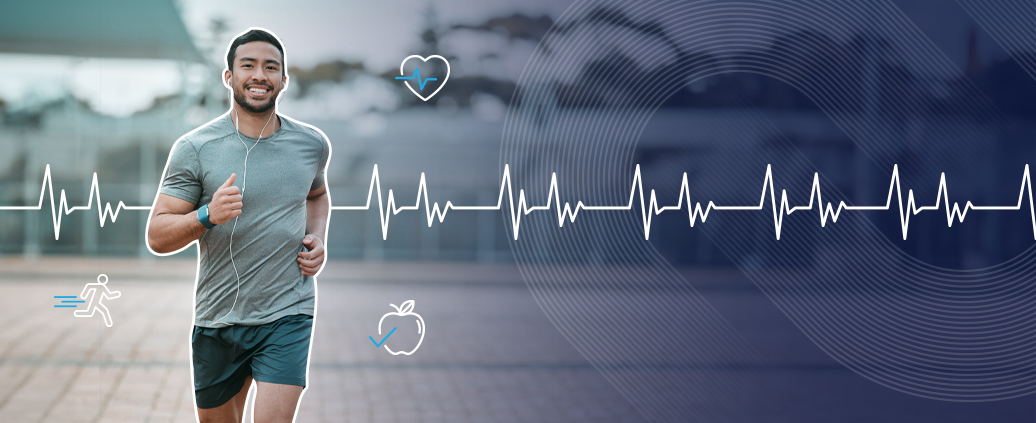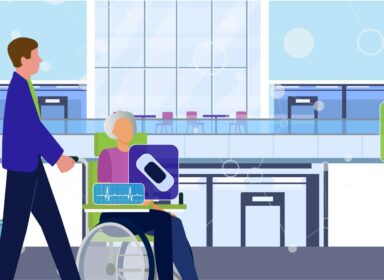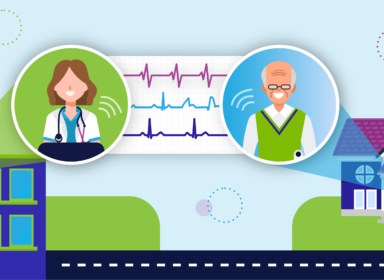Despite the common perception that heart health concerns are exclusive to older individuals, there is a rising prevalence of cardiac risk factors among younger adults.
In 2021, approximately 1 in 5 deaths from coronary artery disease (CAD) occurred in adults younger than 65 years old. Meanwhile, the number of young adults with diabetes has increased from 3% to 4.1%, and obesity rates increased from 32.7% to 40.9% between 2009 and 2020. Obesity remains a key risk factor in cardiovascular disease. COVID-19 may play a role in the upsurge as well, as people who are 25 to 44 years old saw a nearly 30% increase in heart attack deaths during the first two years of the pandemic.
Historically, more detailed cardiovascular analysis was reserved for high-risk populations. With obtrusive monitors, limited visibility, and in-office visits for transmission, cardiac monitoring solutions were prohibitive to widespread adoption. But the tides have turned, uncovering new possibilities in cardiovascular care.
In recent years, virtual telemetry and remote patient monitoring (RPM) have lowered the barriers to adoption, enabling new convenience, visibility, and cost-effectiveness. In this blog post, we will discuss why patient preferences are so important and share practical use cases that can benefit younger patient cohorts.
Adapting Cardiology to Younger Patient Preferences
As younger generations with different preferences age, cardiologists must map treatment methods to their preferences to continue to deliver high-quality care. Virtual telemetry and RPM devices allow physicians to do just that. To better understand how, let’s look at how emerging consumer preferences are satisfied by virtual telemetry solutions:
Convenience
A survey by NRC Health found that 51% of healthcare consumers prioritize convenience and access to care as the most important factors in their decision-making, surpassing considerations like insurance coverage, doctor/nurse conduct, brand reputation, and quality of care. Younger generations have an even stronger preference for convenience—Millennials find doctor’s visits inconvenient and are less likely to schedule preventive visits. Personal technology, like wearable devices, has offered greater levels of convenience, allowing patients the same usability standard in their medical experiences as they have in their daily lives.
Virtual
Younger cohorts rely on virtual experiences for everything from shopping to managing finances. Healthcare is no exception. A study on patient experience in the digital age found that Millennials and Gen Z demonstrate a stronger relationship between perceived usefulness of digital technology and patient experience compared to Generation X. Virtual telemetry supports this shift by eliminating the in-office visits that legacy monitoring solutions require.
Control
Research indicates that Gen Z values honesty, transparency, and authenticity in institutions and will often choose their interactions based on perceived institutional values. This generation has shown a decline in trust towards major institutions and business leaders, emphasizing the need for medical organizations to maintain trust through transparent practices. This also allows younger generations to feel as if they have more active control over their care, encouraging them to participate in it proactively. Virtual telemetry extends this control by allowing them to dictate when, where, and how they receive treatment and care.
Personalization
A Redpoint survey revealed that 75% of patients desire deeper personalization in healthcare services, emphasizing the need for tailored experiences that cater to individual preferences. This is even more true when it comes to younger generations who value personalization in every facet of their life—from the ads they see, to the shows they’re recommended, to their healthcare. Implementing personalized medicine is essential; one study highlighted its importance in engaging younger patients who have grown up with technology integrated into their daily routines. Not only does virtual telemetry do just this by allowing patients to integrate their cardiac care directly into their everyday lives, but this type of technology also enables more precise levels of personalization, as it offers the ability to monitor our heartbeats, which are just as unique as we are.
Real-Life Examples of Virtual Telemetry Making a Difference
Virtual cardiac telemetry is tightly aligned with the preferences of Millennial and Gen Z patients. But how can it tangibly improve their cardiac care? Let’s examine a few practical use cases where it benefitted younger patient populations.
1. Enabling Students Access to Education Without Limits
College students with lifelong cardiac conditions may face challenges when living away from home due to their university’s distance from their cardiologist and other care providers. These patients are often subject to regular tests, and the college environment can make it challenging to carry on with their established care plans. University lifestyle can also introduce new variables that make close and careful monitoring even more critical.
By integrating seamlessly into a student’s daily life, virtual cardiac telemetry enables convenient, high-acuity monitoring from nearly anywhere. Data is transmitted securely to providers in near real-time, providing them clear visibility into their patient’s cardiac health, despite the distance.
2. Enhancing Quality of Life for Young Professionals
Juggling a demanding career and managing a chronic cardiac condition can be challenging, particularly in fast-paced sectors that demand an outsized amount of a young professional’s time and attention. On-site visits for routine cardiac tests can be time-consuming and nearly impossible to fit into a busy life. As a result, young professionals may delay critical elements of their care plan.
Streamlined and unobtrusive, modern cardiac wearables can be discreetly worn under clothing during normal working hours. Data is transmitted continuously throughout the workday, providing clinicians with a reliable view of the patient’s heart activity without additional visits to collect and transmit data.
3. Integration into Preventative Care for Pre-Symptomatic Detection
Integrating remote monitoring into preventative care allows younger cardiac patients to experience freedom while still being able to recognize symptoms before they warrant more serious intervention. When utilizing wearable devices to track vital signs and activity with near real-time data transmission, patients can integrate the device into their routine without changing the flow of their daily lives.
If the provider receives an alert about heart rate variability, they can promptly schedule the patient, review the data, and explain its significance. Even if there are no other symptoms, this early alert allows both doctor and patient to prioritize preventive care. They can then collaborate to devise a personalized plan, including lifestyle adjustments and regular follow-ups, to monitor the condition closely.
4. Supporting Pregnancy for High-Risk Patients
In a high-risk pregnancy where the mother has a history of cardiac issues—or even lacks such a history—virtual telemetry emerges as a crucial tool for ensuring safety. Equipped with a remote cardiac monitoring device linked to a virtual telemetry platform, the expectant mother undergoes continuous monitoring of her heart rate, rhythm, and other vital signs. This technology enables providers to remotely track any deviations from normal cardiac function, allowing for early detection of potential complications.
For example, if the virtual telemetry system alerts the medical team to abnormal heart activity, they can intervene promptly, conducting a thorough evaluation and initiating necessary interventions to stabilize her condition. This proactive approach ensures the well-being of both mother and baby, accounting for cardiac factors associated with high-risk pregnancy and ultimately leading to more positive outcomes.
The MoMe® ARC Unlocks Better Patient Outcomes
Whether enhancing a patient’s lifestyle, improving the timeliness of interventions, or better managing chronic conditions through major life events, virtual telemetry powerfully supports improved quality of life and care outcomes for patients who have not yet reached the ‘high risk’ age for cardiovascular disease. Even more powerful, modern virtual telemetry solutions enable a new era of patient engagement by delivering on younger consumers’ demands for convenience, control, personalization, and more.
InfoBionic’s MoMe ARC® goes beyond legacy cardiac monitoring to deliver transformative benefits for clinicians and patients of all ages. To learn how the MoMe® ARC can make a difference for your practice and your patients, contact us today.


